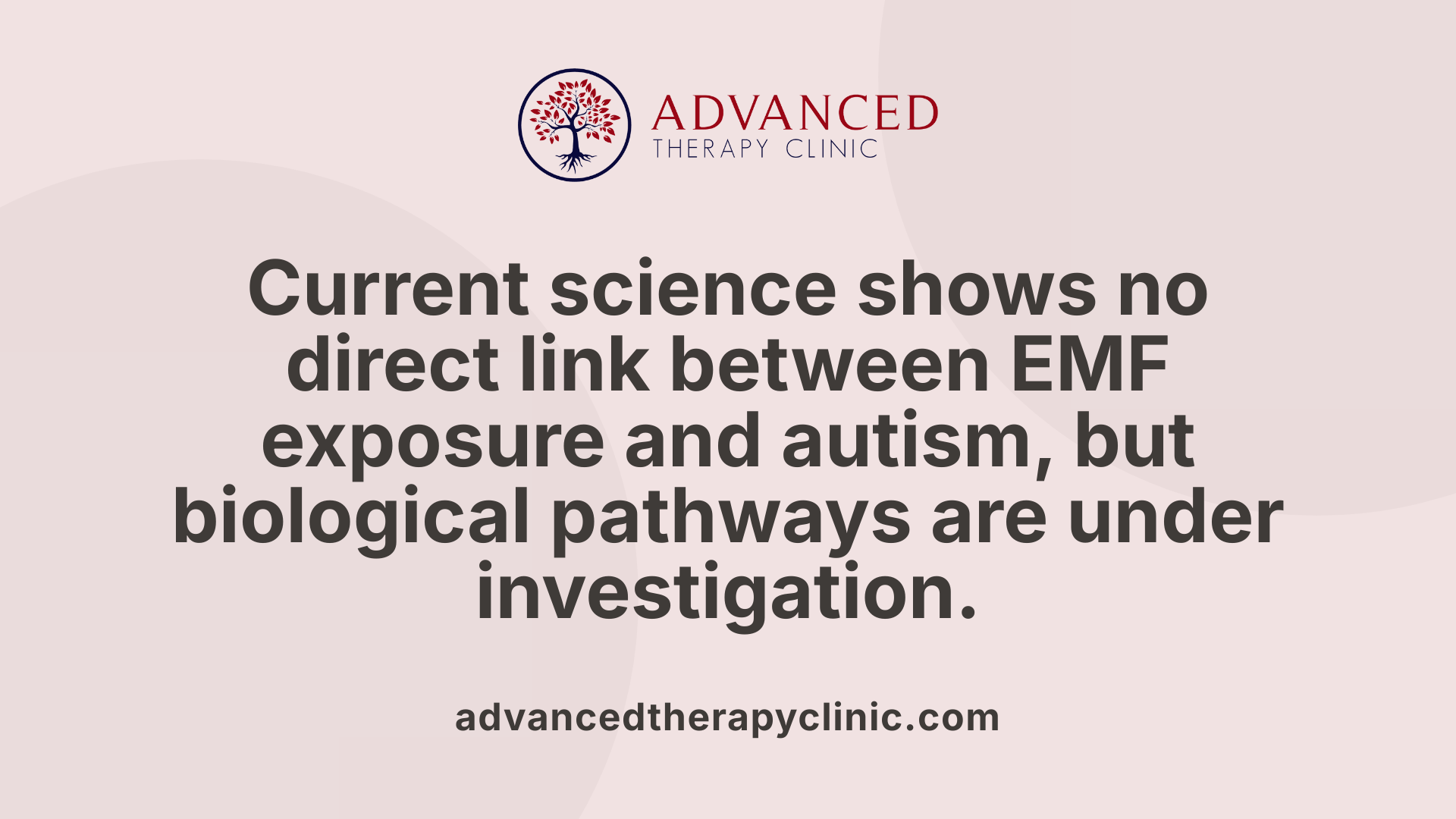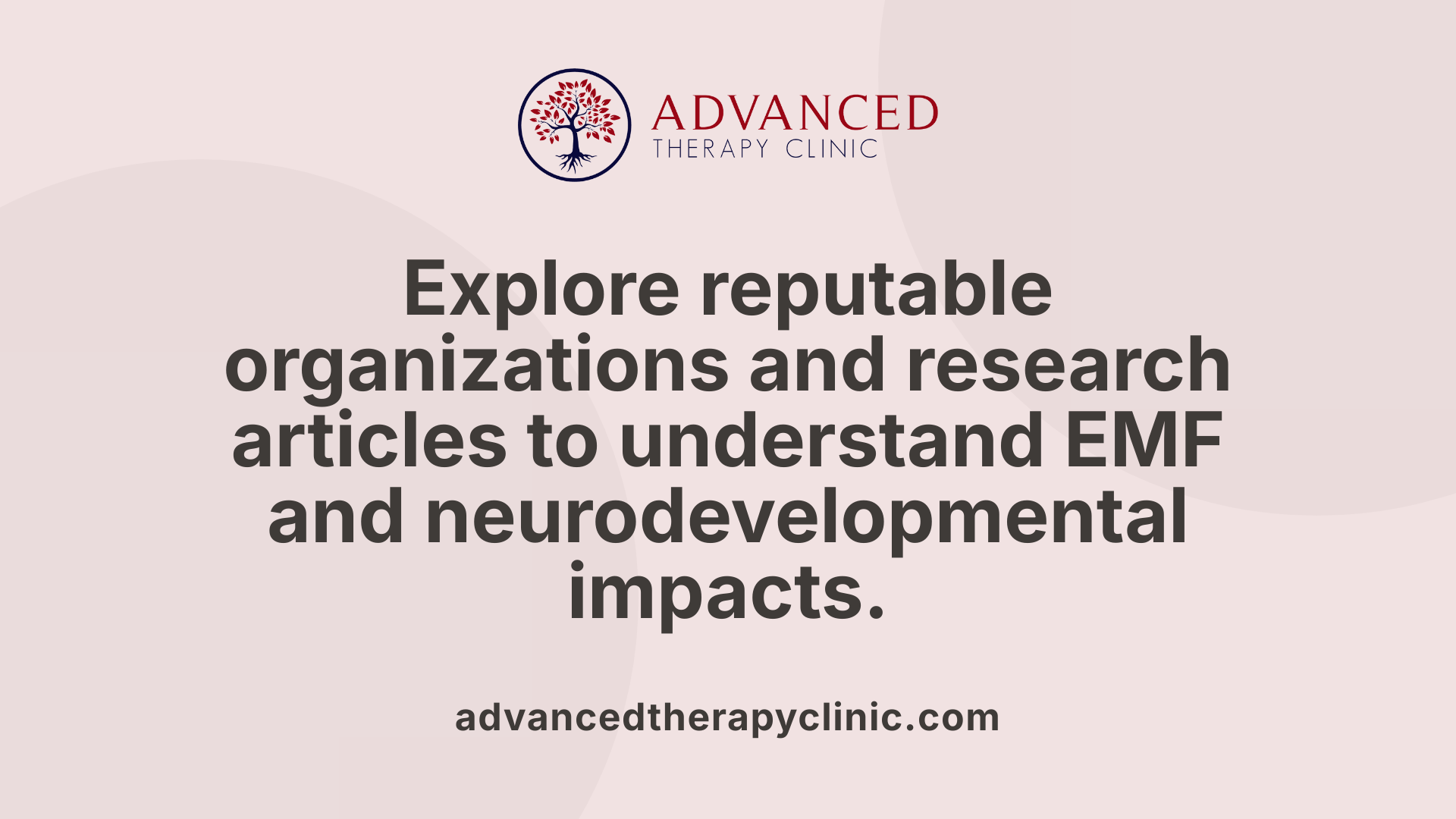Can EMFs Cause Autism?


Understanding the Complex Relationship Between EMFs and Autism
In recent years, rising concerns have led scientists and the public alike to question whether electromagnetic fields (EMFs), those invisible waves generated by wireless devices, power lines, and other electronic sources, could influence the development of autism spectrum disorder (ASD). While comprehensive research is ongoing, current evidence indicates that a direct causal link remains unproven. This article explores what science suggests about EMFs’ potential role in autism, the biological mechanisms that might be involved, existing research directions, and practical considerations for public health.
The Scientific Evidence on EMFs and Autism

What does current scientific research say about the link between EMF exposure and autism?
Research to date suggests that there is no direct evidence tying electromagnetic field (EMF) exposure to the development of autism spectrum conditions (ASCs). Most studies have not found a causative connection that would establish EMFs as a risk factor for autism. However, this area of research is complex and evolving, with some studies indicating that EMFs might influence biological processes which are sometimes altered in individuals with ASD.
Some preliminary research and hypotheses explore the possibility that EMF or radiofrequency radiation (RFR) might impact biological systems related to neurodevelopment. For example, certain experimental studies have suggested EMFs could affect oxidative stress levels, induce inflammatory responses, alter calcium signaling within neurons, and influence neural connectivity—all factors that are often involved in ASD.
Biological processes influenced by EMFs
Research points to a few biological mechanisms through which EMFs could potentially impact neurodevelopment:
- Oxidative Stress: An imbalance between free radicals and antioxidants in the body, which may damage cells and neural pathways.
- Inflammation: Increased inflammatory responses could influence brain development and function.
- Calcium Signaling: EMFs may interfere with calcium channels, affecting neuron communication.
- Neural Connectivity: Alterations in how neurons connect and communicate could influence behaviors associated with ASD.
While these biological effects are observed in some studies, it is important to note that proving causation remains challenging, and the findings are often preliminary.
Pilot studies and their implications
A few small-scale studies have explored the potential therapeutic effects of electromagnetic fields. For instance, a pilot study examined the use of extremely low frequency EMFs (ELF-EMF) as a treatment tool for children with ASD. The results indicated improvements in language skills and behavioral symptoms following treatment. These early findings are promising but limited by small sample sizes and lack of replication.
Research in this domain continues to grow, and these studies highlight the importance of further investigations to confirm potential benefits and understand underlying mechanisms. They also emphasize the need for rigorous safety assessments to determine if EMF exposure could be both safe and potentially beneficial.
Overall perspective
Current science does not establish a direct connection between EMF exposure from everyday wireless devices and autism. Nonetheless, the biological processes that EMFs could influence are relevant to neurodevelopment and ASD. Experts recommend cautious monitoring of EMF exposure levels, especially for vulnerable populations such as children. Meanwhile, researchers continue to explore the intricate interactions between electromagnetic fields and neurodevelopmental processes to provide clearer guidance and safety standards.
| Aspect | Details | Additional Notes |
|---|---|---|
| Current Research | No confirmed causative link | Further studies needed |
| Biological Effects | Oxidative stress, inflammation, calcium signaling, neural connectivity | Potential pathways influenced by EMFs |
| Pilot Studies | Some improvement in ASD symptoms | Limited by sample size |
| Safety Recommendations | Caution in exposure levels | Keep updated with new findings |
| Research Focus | Mechanisms, safety, therapeutic potential | Ongoing scientific efforts |
Understanding the scientific landscape around EMFs and autism helps promote informed decisions regarding technology use and health safety. While more comprehensive research is critical, current evidence suggests cautious optimism and careful monitoring are prudent in the face of widespread EMF exposure.
Educational Resources for Understanding EMF and Neurodevelopment

What educational resources are available to understand the relationship between EMFs and neurodevelopmental conditions?
Several authoritative sources provide comprehensive information about electromagnetic fields (EMFs) and their potential effects on neurodevelopment. Scientific articles, reviews, and official reports from reputable organizations are among the most trusted educational resources in this domain.
The World Health Organization (WHO) and the National Institute of Environmental Health Sciences (NIEHS) are leading agencies that publish guidelines and summaries based on the latest research. These reports explore the basic science of EMFs, including the types of electromagnetic radiation—ranging from extremely low frequency (ELF) fields from power lines to radiofrequency radiation from wireless devices.
Many of these resources clarify that current scientific evidence does not establish a direct link between EMF exposure and neurodevelopmental disorders such as autism spectrum disorder. They provide detailed explanations of how electromagnetic radiation can interact with biological tissues and what biological effects, if any, have been observed in various studies.
The reports and reviews often include discussions on potential risks from common sources like power lines, mobile phones, and wireless devices. They also cover ongoing research efforts aimed at understanding any subtle or long-term impacts of EMF exposure.
Health authorities produce guidance documents and position papers that interpret scientific data for the general public and policymakers. These materials typically include practical advice on how to minimize EMF exposure if desired, such as reducing the time spent near high-intensity sources or using shielding techniques.
Reputable scientific journals, government health agencies, and international organizations offer the most reliable educational materials on the complex relationship between EMFs and neurodevelopment.
Here is a summary table of major educational resources:
| Organization | Types of Resources | Focus Areas | Additional Notes |
|---|---|---|---|
| WHO | Reports, guidelines | EMF science, health recommendations | Global standards, ongoing research summaries |
| NIEHS | Scientific reviews, fact sheets | Biological effects, exposure sources | Focus on environmental health |
| Scientific Journals | Peer-reviewed articles | Research on EMFs and health outcomes | Detailed scientific data |
| Government Agencies | Advice, regulation guidelines | Exposure limits, safety practices | Practical guidance for public |
Understanding EMFs and their potential health impacts requires consulting multiple sources to get a balanced view. By referring to these authoritative materials, the public can stay informed about current scientific consensus and safety recommendations.
Biological Mechanisms Behind EMFs and Autism

How might electromagnetic fields biologically influence autism development?
Electromagnetic fields (EMFs), especially those generated by wireless technology like cell phones and Wi-Fi, differ significantly from natural EMFs. They are characterized by their polarization, coherence, modulation, and pulsation, which make them more bioactive. This increased bioactivity allows EMFs to influence biological processes, particularly those involved in brain development. Research suggests that EMF exposure can impact neurodevelopment by inducing oxidative stress, disrupting ionic balances, and affecting neural circuitry.
One critical pathway involves ionic imbalances. EMFs can alter the functioning of voltage-gated ion channels, particularly through a mechanism known as the Ion Forced Oscillation (IFO)-VGIC pathway. This disturbance can promote the overproduction of reactive oxygen species (ROS), which are harmful molecules that cause oxidative stress. Oxidative stress damages DNA, proteins, and lipids within cells, leading to cellular dysfunction and contributing to neurodevelopmental issues.
Furthermore, EMFs influence neurogenesis, the process by which new neurons are formed, as well as apoptosis, or programmed cell death. Disruptions in these processes during critical developmental windows can lead to atypical brain wiring characteristic of autism spectrum disorder (ASD). Epigenetic modifications, which alter gene expression without changing the DNA sequence, can also be affected by EMF exposure, potentially resulting in long-term changes in brain function.
Ionic imbalances and oxidative stress
Ionic imbalances are a primary impact of EMF exposure, primarily affecting calcium and other ion channels. These ions are vital for nerve signal transmission and overall neuronal health.
| Ionic Imbalance | Effect on Neural Cells | Resulting Impact |
|---|---|---|
| Disrupted calcium signaling | Impaired synaptic transmission | Altered neural communication |
| Increased ROS production | DNA damage, cellular stress | Risk of developmental abnormalities |
| Voltage-gated channel alteration | Changes in neuron excitability | Impact on neural network formation |
Beyond ionic disturbances, EMFs induce oxidative stress, which damages cellular components and impairs normal neural development. This stress can modify the way neurons connect, influencing the formation of neural circuits critical for cognition, social interaction, and communication.
Impact on neural connectivity and brain circuitry
Neurodevelopment requires the precise formation and pruning of neural connections. EMFs can interfere with these processes by modulating ion channel activity and affecting glial cells, which support neuron function.
Altered neuronal excitability due to ion channel modulation can lead to hyper- or hypo-excitability in neural networks. These changes impact the timing of synaptic pruning, a key step in brain maturation. Disrupted connectivity, especially in regions associated with social behavior, language, and sensory processing, is often observed in individuals with ASD.
Glial cells, which regulate the environment for neurons, are also sensitive to EMFs. Changes in glial functions can lead to neuroinflammation and further disrupt neural circuitry.
In summary, EMFs influence neurodevelopment through multiple biologically complex pathways: causing ionic imbalances, generating oxidative stress, and disturbing neural circuit formation. Understanding these mechanisms better can help in developing evidence-based guidelines to reduce potential risks of EMF exposure during critical periods of brain development.
Research Directions and Future Investigations

What are the current research directions regarding electromagnetic radiation’s impact on autism symptoms?
The investigation into how electromagnetic radiation (EMR) might influence autism spectrum disorder (ASD) symptoms is an emerging and actively expanding area of scientific inquiry. Researchers are exploring multiple facets to better understand potential impacts.
One major focus is to identify biological mechanisms that could link EMR exposure to changes in neurodevelopment. Scientists are examining how EMR might affect neural growth, synapse formation, and brain connectivity, which are critical factors in ASD. There is particular interest in the way EMR could alter neurotransmitter systems, such as dopamine and serotonin pathways, which regulate mood, behavior, and cognitive functions.
Another important avenue involves oxidative stress pathways. Some studies propose that EMR exposure could increase oxidative stress in neural tissue, leading to cellular damage or altered neuronal function. These pathways are vital because oxidative imbalance has been observed in individuals with ASD, suggesting a potential connection worth exploring.
Research also examines the correlation between exposure levels from common sources and autism symptoms. Mobile phones, Wi-Fi, cell towers, and other wireless devices emit EMR, and scientists are studying whether higher exposure correlates with increased severity or prevalence of ASD symptoms.
Furthermore, there is growing interest in genetic and epigenetic effects. Some researchers are investigating whether EMR influences gene expression related to neurodevelopment, potentially impacting vulnerability or resilience to ASD.
While numerous studies have surfaced, the results are often inconsistent or inconclusive. Many findings are preliminary, and the scientific community emphasizes the importance of cautious interpretation. Large-scale, well-controlled studies are still needed to establish causality definitively.
Biological mechanisms under investigation
The biological mechanisms being explored in connection with EMR exposure and ASD include:
| Mechanism | Description | Significance |
|---|---|---|
| Neural Development | How EMR affects neural growth and synapse formation | Changes during critical periods might influence ASD risk |
| Neurotransmitter Function | Effects on neurotransmitter levels like dopamine, serotonin | Altered signaling may impact behavior and mood |
| Oxidative Stress | EMR’s role in generating oxidative imbalance | Could lead to neuronal damage and developmental issues |
| Gene Expression | EMR influencing gene activity related to brain development | Potentially alters neurodevelopmental processes |
Assessing exposure levels and causality
One of the ongoing challenges is accurately measuring EMR exposure levels, considering the ubiquity of wireless devices and infrastructure. Researchers are developing better assessment tools, including personal exposure monitors and modeling techniques, to estimate individual exposure accurately.
To establish causality, future studies aim to implement longitudinal designs, larger sample sizes, and control for confounding variables such as genetics, environment, and lifestyle factors. This comprehensive approach will help clarify whether EMR exposure is a contributing factor to ASD symptoms or merely correlated.
In summary, current research is investigating multiple biological pathways and exposure assessments to understand better whether and how electromagnetic radiation might influence autism spectrum disorder. Although progress is promising, definitive conclusions require more rigorous, large-scale investigations.
| Research Focus | Current Status | Future Needs | Notes |
|---|---|---|---|
| Biological Mechanisms | Preliminary findings suggest potential pathways | More detailed molecular studies | Focus on neural, neurotransmitter, and genetic effects |
| Exposure Assessment | Developing better measurement tools | Standardized protocols and large datasets | Necessary for accurate dose-response analysis |
| Causality & Epidemiology | Limited conclusive data | Long-term studies and controlled trials | Critical for policy and public health recommendations |
Environmental Risk Factors and Autism

What environmental factors are associated with increased autism risk, including electromagnetic fields?
Research has identified multiple environmental factors that may increase the likelihood of developing autism spectrum disorder (ASD). Prenatal exposure to pollutants such as air pollution, pesticides, and heavy metals like lead and mercury has been linked to neurodevelopmental disruptions potentially leading to autism. Chemicals commonly found in everyday products, including phthalates and flame retardants, are also of concern. These substances can interfere with normal brain development during critical periods in pregnancy.
Maternal health during pregnancy plays a significant role as well. Conditions such as maternal infections, diabetes, obesity, and high stress levels have been associated with a higher risk of ASD in children. Certain medications taken during pregnancy—such as valproic acid—are known to pose risks for neurodevelopmental issues, including autism.
Advanced parental age, particularly when both parents are older at the time of conception, has been identified as a risk factor as well. This may be related to increased genetic mutations or epigenetic changes in sperm and eggs. Additionally, birth complications—such as premature birth or low birth weight—can also contribute to increased autism risk.
In terms of electromagnetic fields (EMFs), there has been ongoing research to explore whether exposure to EMFs, from sources like cell phones, Wi-Fi, and other electronic devices, plays a role in autism development. To date, the evidence does not conclusively demonstrate a direct link between EMF exposure and autism risk. However, scientific investigations continue, given the ubiquity of electromagnetic exposure in modern life.
The role of electromagnetic fields in the broader context
Electromagnetic fields are invisible areas of energy produced by electrical devices. Concerns about EMFs focus on their potential biological effects, particularly on developing brains. Some studies have suggested that electromagnetic exposure could influence cellular processes, including gene expression and neurodevelopment. However, the current body of research remains inconclusive, and regulatory agencies like the World Health Organization continue to review evidence to determine if EMF exposure warrants specific public health guidelines.
Genetic and environmental interactions
Autism is believed to result from complex interactions between genetic predispositions and environmental influences. Certain genetic variants may make individuals more susceptible to environmental risk factors, such as toxins or maternal health issues. Conversely, environmental exposures might trigger genetic vulnerabilities, leading to developmental disruptions.
This interaction underscores the multifaceted nature of autism etiology. For instance, a child with a genetic predisposition could be at higher risk if exposed prenatally to specific chemicals or stressors. Understanding these interactions is vital for developing preventive strategies and early interventions.
| Environmental Factors | Potential Impact | Explanation |
|---|---|---|
| Air Pollution | Increased risk | Pollutants may interfere with brain development |
| Pesticides | Increased risk | Toxins can disrupt neural pathways |
| Heavy Metals | Increased risk | Lead and mercury are neurotoxic |
| Chemicals (phthalates, flame retardants) | Increased risk | Chemical exposure during pregnancy |
| Maternal Health Issues | Increased risk | Infections, metabolic conditions influence fetal development |
| Medications (valproic acid) | Increased risk | Known teratogenic effects |
| Parental Age | Increased risk | Genetic mutations and epigenetic changes |
| Birth Complications | Increased risk | Premature birth and related issues |
| Electromagnetic Fields (EMFs) | Investigative | Current evidence is inconclusive |
Understanding the impact of these environmental agents helps shape ongoing research and public health policies aimed at reducing risk factors for autism. As research progresses, clearer insights into how these factors interact with genetic vulnerabilities may lead to better preventive measures and interventions.
The Scientific Consensus and Expert Opinions
What is the scientific consensus regarding electromagnetic fields and autism?
The current scientific stance on the possible link between electromagnetic fields (EMF) — including radiofrequency radiation (RFR) — and autism spectrum conditions (ASCs) is cautious and inconclusive. Most researchers agree that there is so far no direct, firm evidence establishing a causal connection between EMF/RFR exposure and autism. Extensive studies have yet to demonstrate that EMF/RFR can reliably induce or influence autism, which remains a complex neurodevelopmental disorder with multifactorial origins.
While definitive proof is lacking, emerging research has highlighted biological mechanisms that could potentially explain how EMF/RFR exposure might interfere with neural development or functioning. Some theorized pathways include oxidative stress, which can damage cells and tissues; mitochondrial dysfunction affecting energy production within neurons; immune dysregulation that might impact neuroimmune interactions; and electrophysiological abnormalities influencing brain activity patterns. These mechanisms are consistent with some biological disturbances observed in individuals on the autism spectrum.
Interestingly, some studies have drawn parallels between cellular effects caused by EMF/RFR and known abnormalities in people with ASCs. For example, oxidative stress and inflammation are common factors in autism research, which raises concerns about environmental contributions, including electromagnetic exposure. Despite such indirect links, the scientific community emphasizes that these are hypotheses requiring more robust validation.
Expert opinions underscore that, given the current data, we cannot definitively claim EMF/RFR exposure causes or worsens autism. Instead, scientists advocate for more detailed and systematic research to clarify potential connections. There is a consensus that more rigorous studies are needed, including well-designed epidemiological research, laboratory experiments, and biological assessments.
Biological plausibility and gaps in research
Biological plausibility refers to whether a proposed cause-and-effect relationship makes sense based on what we know about physiology and biology. In the case of EMF/RFR and autism, some plausible mechanisms have been proposed, but concrete evidence remains elusive.
One significant gap in research is the lack of longitudinal studies that follow individuals over time from prenatal stages through childhood to observe the effects of electromagnetic exposure. This is critical because autism develops during early brain development, and timing of exposure could be crucial.
Moreover, variability in exposure levels, difficulties in measuring individual EMF/RFR exposure accurately, and differences in genetic susceptibility complicate the research landscape. Current studies often face limitations such as small sample sizes, inconsistent methodologies, and the challenge of isolating EMF/RFR effects from other environmental and genetic factors.
The biological effects observed in laboratory conditions, such as cellular stress or alterations in neural activity, are not yet conclusively shown to translate into real-world impacts on human neurodevelopment. This gap underscores the need for studies that connect laboratory findings to population health outcomes.
Recommendations for future studies
Experts recommend several directions for future research to address these gaps:
- Conduct large-scale, prospective cohort studies that track EMF/RFR exposure from pregnancy through childhood.
- Improve methods for assessing individual exposure levels, including personal monitoring devices.
- Examine genetic and environmental interactions to identify susceptible populations.
- Utilize animal models and in vitro systems to explore biological mechanisms in greater detail.
- Explore the role of timing, duration, and intensity of exposure in influencing neurodevelopmental outcomes.
- Foster interdisciplinary collaboration among neurologists, epidemiologists, biologists, and environmental scientists.
By focusing on these areas, future research can better clarify whether electromagnetic exposure poses a genuine risk for autism development or exacerbation and can inform public health guidelines accordingly.
| Aspect | Current Status | Recommendations |
|---|---|---|
| Scientific Evidence | No conclusive link established | Need for long-term, comprehensive studies |
| Biological Mechanisms | Theoretically plausible but not well-validated | Investigate oxidative stress, immune changes, and neural effects |
| Research Gaps | Limited longitudinal data and exposure assessment challenges | Develop precise exposure measurement tools |
| Policy and Standards | Precautionary measures suggested | Reevaluate and update safety standards based on new data |
This evolving field continues to call for cautious interpretation of existing findings and robust inquiry to determine any true risks associated with electromagnetic exposure and autism.
Prevention and Mitigation Strategies
Are there any prevention or mitigation strategies related to EMF exposure that could influence autism risk?
Currently, there are no universally accepted prevention measures specifically designed to reduce autism risk through the mitigation of electromagnetic field (EMF) exposure. This is mainly because scientific research has not yet established a direct causal link between EMF exposure and autism spectrum conditions (ASCs). However, understanding the possible biological effects of EMF and radiofrequency radiation (RFR) has led to cautionary approaches.
Emerging studies suggest that EMF and RFR can induce physiological changes such as oxidative stress, mitochondrial dysfunction, and immune system disturbances. These biological effects could potentially heighten the vulnerability of individuals with existing neurodevelopmental sensitivities, including those with ASCs. Recognizing these risks, public health advocates recommend adopting precautionary measures even in the absence of definitive proof.
Some practical steps include developing stricter public exposure standards to limit everyday wireless device emissions and encouraging the reduction of unnecessary wireless device use, especially among children and pregnant individuals. These measures aim to minimize potential biological impacts that may exacerbate vulnerabilities.
In addition to protective guidelines, research into therapeutic interventions offers interesting possibilities. For example, some experimental studies have explored the use of electromagnetic field (EMF) therapy, particularly extremely low frequency (ELF-EMF) treatment, to address certain symptoms of ASD. While promising, these approaches are not preventative measures for EMF exposure but are instead potential treatment avenues.
Given the current understanding, the most practical advice for population health remains the application of precautionary principles: reduce exposure when possible, especially in sensitive groups, and maintain a cautious stance until more conclusive evidence is available.
| Prevention Strategies | Description | Additional Notes |
|---|---|---|
| Developing Exposure Standards | Implement stricter limits on EMF emissions based on emerging science | Aims to reduce overall exposure levels |
| Limiting Wireless Device Use | Minimize unnecessary use of cell phones, tablets, and Wi-Fi, particularly in children | Protects vulnerable populations from potential effects |
| Public Education Campaigns | Increase awareness about EMF exposure and ways to reduce it | Empowers individuals to make informed choices |
| Research on Therapeutic Uses | Investigate ELF-EMF therapy for ASD symptom management | Not a preventative measure but a treatment option |
Future Directions in Regulation
As research continues, future regulatory approaches might include setting more stringent safety thresholds for EMF exposure in residential and public spaces. Governments and health organizations are encouraged to monitor scientific developments and update guidelines accordingly. This proactive stance can help mitigate risks as understanding of EMF’s biological impacts deepens.
Furthermore, integrating precautionary principles into public health policies, especially for vulnerable populations like children and pregnant women, is vital. Promoting safer technology designs, such as low-emission devices, and encouraging best practices for device usage can also contribute to risk reduction.
| Future Regulatory Measures | Goals | Expected Impact |
|---|---|---|
| Stricter Exposure Limits | Align standards with the latest scientific findings | Reduce overall EMF exposure levels |
| Enhanced Public Awareness | Educate about EMF risks and safe device usage | Foster community-based risk reduction |
| Safer Technology Development | Incentivize low-EMF emission devices and infrastructure | Minimize biological impact potential |
| International Policy Coordination | Harmonize regulations globally for consistency and effectiveness | Globally consistent safety standards |
While comprehensive prevention strategies are still under development, current measures emphasize reducing unnecessary exposure and staying informed about emerging research. These steps can help protect vulnerable groups and pave the way for more definitive policy actions in the future.
Looking Ahead: Navigating the EMF-Autism Nexus
While current scientific consensus does not confirm a direct causal link between electromagnetic fields and autism spectrum disorder, the biological plausibility of EMFs influencing neurodevelopmental processes warrants ongoing research. Experts advocate for cautious use of wireless technology, continued exploration of biological mechanisms, and stricter safety standards to protect vulnerable populations. Public health guidance emphasizes minimizing unnecessary exposure and remaining vigilant to emerging data. As science advances, a clearer understanding might emerge, potentially shaping future policies and intervention strategies to ensure safer environments for neurodevelopment.
References
- Effects of Extremely Low-Frequency Electromagnetic Field ...
- Autism and EMF? Plausibility of a pathophysiological link - Part I
- Autism and EMF? Plausibility of a pathophysiological link – Part I
- Autism and EMF? Plausibility of a pathophysiological link – Part I
- Effects of Extremely Low-Frequency Electromagnetic Field ... - PubMed
- Autism and EMF? Plausibility of a pathophysiological link - Part I
- Effects of Extremely Low-Frequency Electromagnetic Field ...
Recent articles

Expressive Speech Delay 2-Year-Old
Understanding and Addressing Expressive Speech Delay in Toddlers

How Speech Recognition Works
Unlocking the Power of Speech Recognition in Therapy and Healthcare

Autism and Head Size
Understanding the Complex Relationship Between Autism and Head Size

Occupational Therapy in Autism
Enhancing Independence and Quality of Life Through Occupational Therapy in Autism

Do Autistic People Understand Sarcasm?
Navigating the Nuances: Understanding Sarcasm and Social Communication in Autism

Autism Routines
Crafting Effective Daily Structures for Children with Autism

